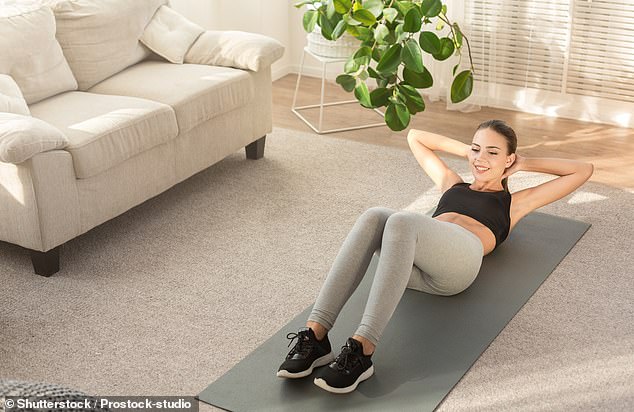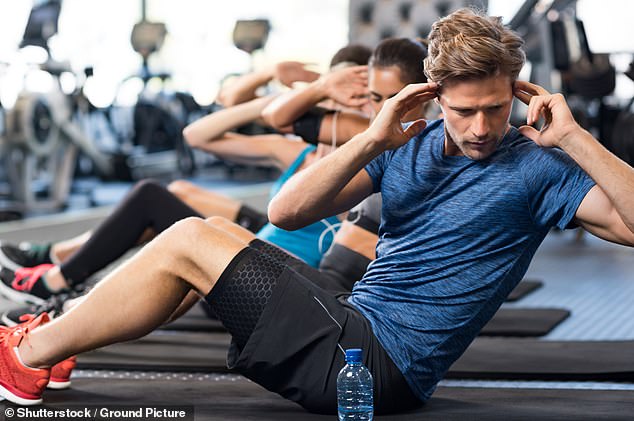Whilst almost anyone can do a crunch or a sit-up, for most of us the higher reps remain the preserve of avid gym-goers, Olympians and celebrities.
However, in reality, physiologists and personal trainers alike say crunches are an accessible exercise for any age group, with a plethora of health benefits.
They help build the core muscles, which work together to not only keep us upright, but are the foundation of good back health and posture which can help ward off back pain and prevent osteochondritis—which causes cartilage to separate from the bones within a person’s joints.
As we age, having good core strength helps us deal with wear and tear as our spine compresses and helps protects us from falls, with all functional movements, from sitting to walking, requiring core strength.
‘Your core doesn’t function in isolation. It works as an integrated system to stabilise your entire body during real-world movements,’ British Army veteran turned physiotherapist Nell Mead says.
Therefore, focusing on exercises that target connection with deeper core muscles as well as the rectus abdominis, which sit closer to the surface, can help slash the risk of injury, especially in the lower back as it strengthens muscles and tissues in the spine region.
In fact, many physiologists say if your goal is to walk out of the gym with a chiseled six-pack, you’re missing the point—thought this isn’t entirely out of reach.
Rather, the abdominal muscles are just one of the major muscle groups that constitute the core; it also includes deep muscles in the spinal column, hips, pelvis and back as well as smaller muscles along the spine and diaphragm.

It’ the holy grail of fitness – a toned midriff – but a strong core is crucial for stability and back health as you age
It is essentially the body’s power source—meaning that one singular crunch isn’t quite going to cut it.
How many crunches you should be able to do as you get older
According to Nico Schwandt, a physiologist specialising in pain and chronic conditions at Stone London gyms, 30-39 year olds should be able to perform 40 crunches at least two or three times a week .
As we age, this number slightly declines, but 50-59-year-olds should still be able to manage around 20 crunches a few times a week. And for 60-69-year olds, all is not lost, with the trainer recommending around 10 crunches for this age group.
‘However, these numbers are markers to aim for,’ he told The Telegraph, ‘provided that you have the right technique and a reasonable level of fitness.
‘Remember, Mike Tyson is 59 and can probably perform more crunches than most people at 29.’
However, according to personal trainer Ben Simpkins, it’s not all about reps—one critical component missing in most core routines is rotation and variation.
‘Don’t waste energy on endless crunches—include as many variations as possible that challenge to core in different ways to hep target the deeper muscles that wrap horizontally around your midsection.’
Many daily activities that we perform without thinking, like walking, stretching to reach the top shelf, and even unloading the dishwasher involve rotating the body, so it’s a good idea to train the obliques to protect the spine.

Gymnastic-style exercises – which use body weight to build muscle – are also brilliant for abs, says personal trainer Liz Marsland
Back to basics: how to crunch correctly
For beginners, the most important thing is focusing on form, starting with lower reps performed perfectly before upping the load.
‘The goal with a crunch is not to sit up, but to create controlled spinal flexion, shortening the distance between the rob cage and pelvis without the hips taking over,’ Josh Silverman, head of education at Third Space, told the Telegraph.
1. Lie down on your back with your feet planted hip-width apart. The lower back should remain in contact with the floor at all times to maintain tension in the abdominal muscles which will help build strength.
2. Exhale and lift you upper body off the mat, vertebra by vertebra. The range should stop when your shoulder blades are no longer touching the floor.
3. Inhale and return back to the starting position, making sure not to drop your chin and strain your neck.
‘This basic movement creates the foundation for strong abdominal muscles,’ says London-based personal trainer Liz Marsland.
‘Once you’ve built that base, core-specific exercises will be far more effective at developing defined, visible abs.’
The personal trainers suggests a number of variations that can help stabilise the spine and improve posture as we age—with some studies suggesting that even a high intensity run can activate the abdominal muscles as much as core exercises.

Balancing on one leg continuously for more than 40 seconds is a key sign of strength and mobility among 18 to 39-year-olds, the health service says
Research has also long shown that exercise can not only help protect your spine, but it reduces the risk of heart disease and other health conditions, including dementia.
Here we break down some of their favourite exercises that improve balance, strength and stability and should help you live healthier for longer…
A few exercises to supercharge your crunches 1. Dead bugs
Lie on your back with your legs in the air and knees bent in table top position. Raise your arms so they are pointing to the ceiling, and keeping your spine flush against the floor, extend your left leg and lower your right arm behind your head then return to the starting position.
Repeat with the opposite arm and leg.
2. Russian twists or twisting crunch
Unlike crunches and planks, Russian twists require you to use what’s called a transverse range of motion, or rotation, toning an increased quantity of muscle in the abdominal area.
The exercise involves twisting your core while sitting on the floor and leaning back with your knees bent, to target the obliques and abductors on the side of the body as well as the deeper core muscles, experts say.
What’s more, simply the act of holding yourself up at an angle requires a lot of core strength, which makes the movement useful for beginners too.
3. Weighted crunch
Lie flat on your back with your legs up and knees bent. Keeping the small of your back on the floor, twist opposite elbow to opposite knee controlling the movement as you go.
4. Side-lying crunch
Lie on the floor on your left side, with your legs bent and a pillow between your knees. Squeeze the pillow as you rotate your upper body until your left arm is reaching toward the ceiling and your right arm towards the opposite wall.
Lift your shoulders off the mat before lowering and returning to the starting position. Repeated five times on each side to work the external obliques.
